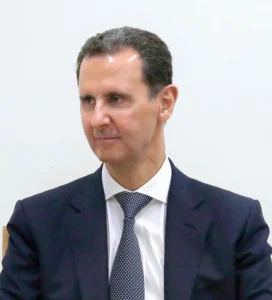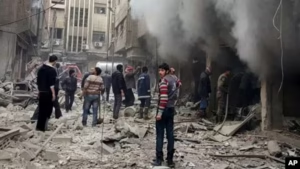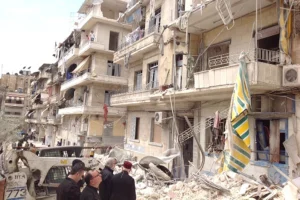The Fall of Bashar al-Assad A Turning Point for Syria’s Future

On December 7, 2024, the world watched as a major and dramatic event unfolded in Syria. Opposition forces declared the capital megacity, Damascus, “ delivered.” They blazoned that President Bashar al-Assad had fled the country, marking the collapse of one of the most brutal administrations in ultramodern history. This vital moment is the result of times of conflict that has destroyed the nation, leaving millions dead and displaced. As the Syrian Civil War comes to a shocking and unanticipated close, the fall of Assad opens up a new chapter for the country, full of both stopgap and query.
The Road to Damascus Events Leading to Assad’s Downfall
The rapid-fire descent by opposition groups, including Hayat Tahrir al-Sham ( HTS) and other recusant coalitions, led to the fall of Assad’s capital. The instigation of this unforeseen military advance forced Assad’s patriots to abandon crucial areas, including the presidential palace, as the recusant forces made their way into Damascus. As Assad fled the country under unclear circumstances, reports suggested he left aboard a private airplane, leaving behind his governance’s worsening structure.
The fall of Damascus marked the sanctioned collapse of the Assad governance after over a decade of civil war. Assad’s government, which had been propped up by important abettors like Russia, Iran, and Hezbollah, appeared to have lost its grip on power despite their military support. The rebellion, which began in 2011 as part of the broader Arab Spring demurrers, escalated into a violent conflict that has seen the involvement of colorful transnational powers and the rise of multitudinous recusant coalitions. The eventual defeat of Assad represents a dramatic turn of events that surprised the world.
Transnational Responses to the Fall of Assad
As news of Assad’s downfall spread, responses from the global community were mixed, pressing the complexity of Syria’s geopolitical situation. Countries that had opposed Assad’s governance celebrated the development as a palm for the Syrian people. The United States, Turkey, and Gulf nations, who had long called for Assad’s junking, expressed conservative sanguinity. US officers, while admitting the significance of Assad’s exit, emphasized the need for a political result that ensures stability and peace for the war-torn nation.
still, Russia and Iran, Assad’s primary backers, were quick to state their enterprises. Both nations have invested heavily in the survival of the Assad governance, furnishing military aid and fiscal coffers. Russian Foreign Minister Sergey Lavrov called for an immediate ceasefire and prompted a peaceful resolution to the conflict. The fear of insecurity spreading throughout the region was palpable, especially considering the presence of jihadist coalitions and the ongoing trouble from ISIS.
While these transnational powers express differing views, the focus has now shifted to what comes next for Syria. The fall of Assad may signal the beginning of a new chapter, but the question remains: Can Syria transition from a war-torn, authoritarian state to a peaceful, popular nation?
What’s Next for Syria Challenges Ahead

Syria’s future remains uncertain as it faces a host of challenges. The immediate task will be to establish a transitional government, but this is no simple feat. The country has been deeply divided by times of war, and the colorful opposition groups, including Kurdish fighters, Islamist coalitions, and temporal revolutionists, have little in common. These groups must now find a way to cooperate if Syria is to have any chance of peace.
The opposition’s pledge to form a transitional government is a pivotal step, but the process will be fraught with difficulties. The Syrian population is exhausted from times of violence, and the political geography is fractured. Any new government must reflect the diversity of Syria’s population, which includes colorful ethnical, religious, and political groups, and insure their representation in the political process.
also, Syria’s structure has been destroyed by over a decade of warfare, and its frugality is in shambles. Rebuilding the country will bear massive transnational aid, as well as combined trouble to restore introductory services, rebuild homes, and rehabilitate the frugality. The situation is dire, and without a comprehensive plan for reconstruction, the country may fall into further chaos.
Syria’s Political Transition The part of the International Community

The transnational community will play a critical part in shaping Syria’spost-Assad future. Organizations like the United Nations and the European Union, along with indigenous powers, must support the creation of a new government in Syria that’s both inclusive and representative of all Syrians. A peaceful resolution will bear dialogue between the colorful coalitions, including the Assad patriots, the opposition groups, and the Kurdish forces, who have all played a part in the conflict.
In addition to the political transition, the transnational community must also concentrate on rebuilding Syria’s structure and frugality. This will involve significant investment in sectors similar as education, healthcare, and energy, as well as furnishing philanthropic aid to the millions of displaced Syrians. Without transnational support, Syria’s path to recovery will be long and delicate.
The part of Russia and Iran in the post-Assad period will be of particular significance. While both countries have supported Assad, they must now fete the need for a peaceful transition and work with transnational mates to ensure stability in Syria. Their involvement in the peace process will be pivotal, as they have got the service and political influence to support or disrupt the transition.
The Humanitarian Crisis The Impact of Assad’s Fall on Syrian Civilians

While the fall of Assad is a major political shift, the philanthropic extremity in Syria is far from over. Over 500,000 people have failed in the conflict, and millions more have been displaced. The collapse of the Assad governance won’t incontinently end the suffering of the Syrian people, and numerous face dire conditions in exile camps both inside and outside the country.
Syria’s metropolises have been destroyed, and introductory services like water, electricity, and healthcare are scarce. The precedence for the new government will be to address these pressing philanthropic requirements and begin the delicate task of rebuilding the country from the ground up. transnational aid associations, similar as the Red Cross and UNHCR, must continue their work in furnishing support to displaced Syrians and easing their return to their homes.
Hope for the Unborn Rebuilding Syria from the Ashes

Despite the challenges, there’s a stopgap for a better future for Syria. The fall of Assad represents the end of a period of brutal absolutism, and with it comes the eventuality for a new morning. Syrians have long endured inconceivable suffering, and now they must work together to rebuild their country and produce a society that values peace, republic, and moral rights.
The road to recovery will be long, but it isn’t insolvable. The Syrian people have shown remarkable adaptability over time, and their expedients for a better future remain strong. With the right support and leadership, Syria can crop from this extremity and find its way toward peace and substance.
Conclusion
The fall of Bashar al-Assad marks a major moment in the Syrian Civil War. After over a decade of conflict, Syria stands at a crossroads, facing an uncertain future. While the road to recovery will be delicate, the fall of Assad represents a chance for Syrians to rebuild their country and produce a better future for generations to come. The transnational community must play a crucial part in supporting this transition, but eventually, it’ll be the Syrian people who determine their fortune.
As Syria enters a new phase, it’s important to flashback the assignments of the history and work toward a future of peace, justice, and concinnity. The Syrian people earn nothing lower.
Wikipedia of Bashar al-Assad Click Here

It’s actually a great and useful piece of information. I am happy that you simply shared this helpful info with us. Please keep us informed like this. Thank you for sharing.
Este site é realmente demais. Sempre que consigo acessar eu encontro coisas incríveis Você também vai querer acessar o nosso site e saber mais detalhes! conteúdo único. Venha descobrir mais agora! 🙂